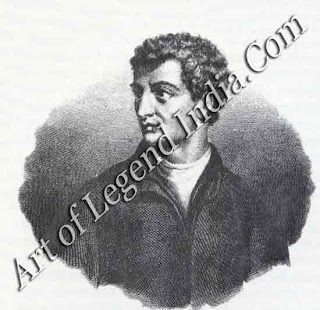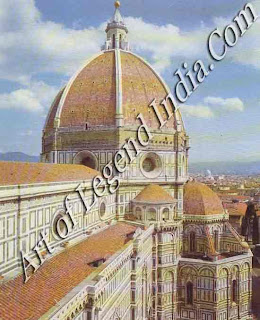A Year in the Life 1436
With
the consecration of its magnificent cathedral, Florence established itself as
the centre of the early Renaissance. The rest of Europe was dominated by
conflict: in Bohemia, the brutal Hussite war had just ended, while the Hundred
Years War between France and England was into its last phase.
In Fra
Angelico's Florence, the great event of 1436 was the consecration of the city's
cathedral by Pope Eugenius IV. This was a matter for civic as well as
ecclesiastical rejoicing: the building had attracted the interest and financial
resources of several generations of Florentines, fired with the idea of
erecting the 'most beautiful and honourable church in Tuscany'. Crowned by
Filippo Brunelleschi's soaring dome, the cathedral was the work of the most
skilful builders and craftsmen of the time. In 1436, Brunelleschi was still
occupied in raising the lantern (a light open structure) on the top of the
dome, and the sculptors Donatello and Luca della Robbia were working on the
interior decoration. Another great master, Lorenzo Ghiberti was engaged on the
bronze Gates of Paradise for the Baptistry Doors (1425-52).

For the
perpetually warring Italian city states, 1436 was a year of relative
tranquillity. On the other side of the Alps, too, it was a year when the turmoils
which had been tearing the rest of Europe apart had temporarily abated. In
Central Europe, the coronation of the Holy Roman Emperor Sigismund as King of
Bohemia marked the end of his long struggle against the Hussites. They had
driven him out on his succession to the throne in 1420, holding him responsible
for the burning of their mentor, the religious reformer, John Hus.
The
Hussites had strongly resisted no fewer than five military crusades mounted
against them by Sigismund and the Pope. Known as 'the warriors of God', they
fought with fanatical zeal, sweeping through Bavaria, Silesia, and Saxony and
into Poland. Their fearful war-wagons, equipped with pikemen, small arms and
primitive cannons, made them formidable in attack and unassailable in defence.
The Hussites detested the worldliness and degeneracy of the Church of Rome and
they called for radical reforms: they wanted corrupt priests to be tried in
civil courts and Church property to be expropriated. Their armed defiance made
a deep impression on the rest of Europe, foreshadowing the Protestant
Reformation.
THE HUNDRED YEARS WAR
 In
Northern Europe the Hundred Years War entered its final stages. The burning of
Joan of Arc in 1431 had united the French, and the English were now out-maneuvered
at every turn. In April 1436, the English troops were finally driven out of
In
Northern Europe the Hundred Years War entered its final stages. The burning of
Joan of Arc in 1431 had united the French, and the English were now out-maneuvered
at every turn. In April 1436, the English troops were finally driven out of Paris
and later the year, following a string of obliged to defend the besieged port
of Calais vital to their international wool trade. Back home in England, the
Archbishop of Canterbury was engaged in establishing the College of All Souls
in Oxford, 'as a memorial and offering for the souls of those who fell in the
Wars for the crown of France', while the poet John Lydgate set about trying to
restore his countrymen's patriotic pride:
Remember
now ye Flemings, upon your own shame,
When ye
laid seige to Calais, Ye were right still to blame,
For
more of reputation be Englishman than ye,
And
come of more gentle blood, of more antiquitie.
As the
year drew to its close, the Scots King, James I, was forced to call off a
punitive siege on Berwick-on-Tweed, on being informed by his Queen of a plot
being laid against his life by some of his nobles. He took refuge in the cold,
grey, Dominican priory at Perth, where soon afterwards he was brutally
murdered. In the manner of 15th-century Scottish architecture it would have
been a very different place to the peaceful Dominican convent of San Marco
where Fra Angelico was soon to begin work.
A TRANQUIL INTERLUDE
Vasari
records that Fra Angelico said that to practise the art of painting one should
lead a quiet and untroubled life. In the violent society of 15th-century
Europe, he was fortunate to have enjoyed such felicity.
Writer
– Marshall Cavendish
 In
Northern Europe the Hundred Years War entered its final stages. The burning of
Joan of Arc in 1431 had united the French, and the English were now out-maneuvered
at every turn. In April 1436, the English troops were finally driven out of Paris
and later the year, following a string of obliged to defend the besieged port
of Calais vital to their international wool trade. Back home in England, the
Archbishop of Canterbury was engaged in establishing the College of All Souls
in Oxford, 'as a memorial and offering for the souls of those who fell in the
Wars for the crown of France', while the poet John Lydgate set about trying to
restore his countrymen's patriotic pride:
In
Northern Europe the Hundred Years War entered its final stages. The burning of
Joan of Arc in 1431 had united the French, and the English were now out-maneuvered
at every turn. In April 1436, the English troops were finally driven out of Paris
and later the year, following a string of obliged to defend the besieged port
of Calais vital to their international wool trade. Back home in England, the
Archbishop of Canterbury was engaged in establishing the College of All Souls
in Oxford, 'as a memorial and offering for the souls of those who fell in the
Wars for the crown of France', while the poet John Lydgate set about trying to
restore his countrymen's patriotic pride: 













0 Response to "Italian Great Artist Fra Angelico - A Year in the Life 1436 "
Post a Comment